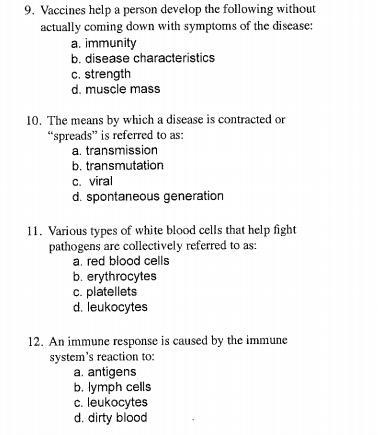Answers
10: A
11: D
12: A
13: D
14: B
15: A.
Can you please mark me brainliest THANKS
hope this helped
Related Questions
Which diagram shows magnets that will attract each other? 2 bar magnets side by side with their long axes vertical, both red S on top and blue N on bottom. 2 bar magnets top to bottom with their long axes vertical, the top one with red S on top and blue N on bottom and the bottom magnet with blue N on top and red S on bottom. 2 bar magnets top to bottom with their long axes vertical, the top one with blue N on top and red S on bottom and the bottom magnet with red S on top and blue N on bottom. 2 bar magnets top to bottom with their long axes vertical, the top one with red S on top and blue N on bottom and the bottom magnet with red S on top and blue N on bottom.
Answers
2 bar magnets top to bottom with their long axes vertical, the top one with red S on top and blue N on bottom and the bottom magnet with red S on top and blue N on bottom. this diagram shows magnets that will attract each other. Hence option D is correct.
What is Magnet ?A permanent magnet is an item constructed of magnetised material that generates its own persistent magnetic field. A refrigerator magnet, for example, is commonly used to hold notes on a refrigerator door. Ferromagnetic (or ferrimagnetic) materials are those that can be magnetised and are strongly attracted to a magnet. These include the elements iron, nickel, and cobalt, as well as their alloys, some rare-earth metal alloys, and naturally occurring minerals such as lodestone. Although ferromagnetic (and ferrimagnetic) materials are the only ones that are strongly attracted to a magnet and are widely thought to be magnetic, all other substances respond weakly to a magnetic field via one of many different forms of magnetism.
Hence option D is correct.
To know more about magnet :
https://brainly.com/question/21974887
#SPJ3.
What is the centripetal force for a roller coaster if the mass is 10 kg and the normal force is 25 N?
Answers
Answer:
Fc = 123 Newton
Explanation:
Net force can be defined as the vector sum of all the forces acting on a body or an object i.e the sum of all forces acting simultaneously on a body or an object.
Mathematically, net force is given by the formula;
[tex] Fnet = Fapp + Fg[/tex]
Where;
Fnet is the net force.
Fapp is the applied force.
Fg is the force due to gravitation.
Given the following data;
Normal force = 25N
Mass = 10kg
To find the centripetal force;
From the net force, we have the following formula;
Fc = N + mg
Where;
Fc is the centripetal force.
N is the normal force.
mg is the the weight of the object.
Substituting into the formula, we have;
Fc = 25 + 10(9.8)
Fc = 25 + 98
Fc = 123 Newton
Please help I’ll mark you brainliest
Answers
Answer:
Percentage:
Rr = 50% because it's 2/4 (for both or 25% each since you have them separate)
rr = also 50%, because it's also 2/4.
Phenotype:
Rr = heterozygous
rr = "hozygous" recessive
In addition, RR is "hozygous" dominant
Explanation:
They said the hozygous is a swearword LOL.
Stars that are not very hot but give off a lot of light are
O nebula
O main sequence stars
giants
O giants
O dwarfs
Answers
[tex]\huge{\textbf{\textsf{{\color{navy}{An}}{\purple{sw}}{\pink{er}} {\color{pink}{:}}}}}[/tex]
Giants.
thankshope it helps.Explanation:
giants are those stars that are not so hot but give a lot of light
A diver comes off a board with arms straight up and legs straight down, giving her a moment of inertia about her rotation axis of 18kg⋅m2. She then tucks into a small ball, decreasing this moment of inertia to 3.6kg⋅m2. While tucked, she makes two complete revolutions in 1.2s.
Required:
If she hadn't tucked at all, how many revolutions would she have made in the 1.5 s from board to water?
Answers
Answer:
θ₁ = 0.5 revolution
Explanation:
We will use the conservation of angular momentum as follows:
[tex]L_1=L_2\\I_1\omega_1=I_2\omega_2[/tex]
where,
I₁ = initial moment of inertia = 18 kg.m²
I₂ = Final moment of inertia = 3.6 kg.m²
ω₁ = initial angular velocity = ?
ω₂ = Final Angular velocity = [tex]\frac{\theta_2}{t_2} = \frac{2\ rev}{1.2\ s}[/tex] = 1.67 rev/s
Therefore,
[tex](18\ kg.m^2)\omega_1 = (3.6\ kg.m^2)(1.67\ rev/s)\\\\\omega_1 = \frac{(3.6\ kg.m^2)(1.67\ rev/s)}{(18\ kg.m^2)}\\\\\omega_1 = \frac{\theta_1}{t_1} = 0.333\ rev/s\\\\\theta_1 = (0.333\ rev/s)t_1[/tex]
where,
θ₁ = revolutions if she had not tucked at all = ?
t₁ = time = 1.5 s
Therefore,
[tex]\theta_1 = (0.333\ rev/s)(1.5\ s)\\[/tex]
θ₁ = 0.5 revolution
Determine how would the frequency of the pendulum change if it was taken to the moon by finding the ratio of its frequency on the moon fM to its frequency on the earth fE. Suppose that gE is the free-fall acceleration on the earth and gM is the free-fall acceleration on the moon.
Express your answer in terms of some or all of the variables l, m, gE, gM.
fM/fE = ?
Answers
For the pendulum taken to the moon, The frequency change that would occur is mathematically given as
[tex]\frac{Fmoon}{Fearth}=0.408[/tex]
What frequency change would occur to the pendulum if it was taken to the moon?Generally, the equation for the Time period is mathematically given as
[tex]T=2\pi\sqrt{L/g}[/tex]
Therefore
[tex]\frac{Fmoon}{Fearth}=\frac{\sqrt{g/6L}}{\sqrt{g/6L}}\\\\\frac{Fmoon}{Fearth}=\sqrt{1/6}[/tex]
[tex]\frac{Fmoon}{Fearth}=0.408[/tex]
In conclusion, The frequency change
[tex]\frac{Fmoon}{Fearth}=0.408[/tex]
Read more about frequency
https://brainly.com/question/24623209
Answer:
.408
Explanation:

